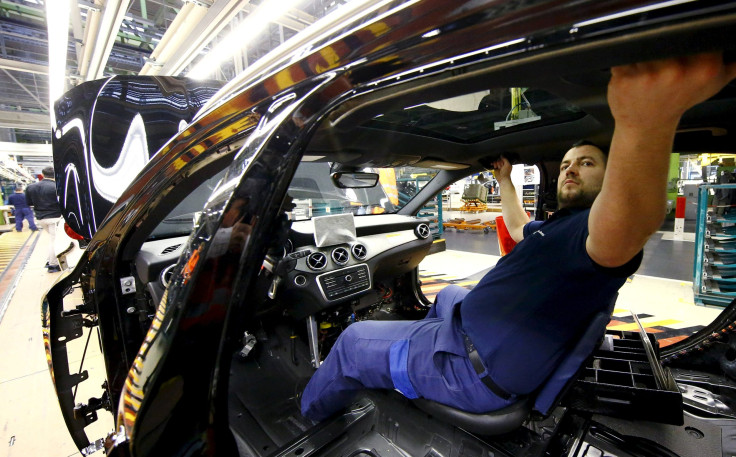European Commission Lowers 2016 Growth, Inflation Forecasts Over Global Slowdown And Brexit Concerns

UPDATE: 5:10 a.m. EDT — The European Commission on Tuesday lowered its growth and inflation forecast for the 19-nation eurozone and the wider European Union.
In its 2016 spring forecast, the commission projected that Gross Domestic Product growth in the euro area would remain “modest” at 1.6 percent this year — down from 1.7 percent in 2015 and below 1.7 percent growth it forecast in February. GDP growth in the 28-nation EU, meanwhile, is expected to be moderate from 2 percent in 2015 to 1.8 percent this year, less than the previous projection of 1.9 percent.
In a statement, the commission attributed the bleaker forecast to prevailing weakness in global growth as well as to risks and uncertainty associated with the looming Brexit referendum. “Fiscal policy in the euro area is expected to be supportive of growth this year. But although oil prices fell again in early 2016 and prolonged the boost to real disposable incomes, the strength of this support should gradually fade as the oil price rebounds,” the European Commission said in a statement. “Similarly, although euro area exports are still benefiting somewhat from the euro’s past depreciation, the currency’s recent rise could make the euro area more susceptible to the effects of slower external growth.”
Inflation in the eurozone is now expected to come in at 0.2 percent in 2016, down from the February estimate of 0.5 percent, and 0.3 percent in the EU, down from the previous estimate of 0.5 percent. as low oil prices continue to drag down consumer prices.
“Global factors have been the driving force behind recent inflation developments and are expected to remain so in the near term. External price pressures continued to weaken in the first months of 2016. This mirrors the sharp fall in energy prices during the same period which has had an impact across global supply chains. In tandem, a major factor holding down global producer prices is the overcapacity in several emerging market economies, particularly China,” the commission said in its report.
Original story:
On Tuesday, the European Commission will release its spring economic forecast for the 28-nation European Union and the 19-nation eurozone. The forecast, which comes just days after official data showed that economic recovery in the region was gathering steam, is expected to provide further insights into how the drop in oil prices and the slowdown in China are likely to impact growth in Europe.
The forecast for this year and the next will include data on gross domestic product growth, inflation, employment and budget deficits.
“We will see how optimistic the European Commission is in its spring forecast,” Antonia Oprita, a columnist with Real Money, said. “We have to see whether these forecasts are better than the ones released in February.”
The European Commission releases economic forecasts for the EU three times a year. In its previous forecast published in February, it predicted that the euro area economy would grow at 1.7 percent this year and climb to 1.9 percent in 2017. For the European Union as a whole, the GDP was forecast to grow at 1.9 percent in 2016 and rise to 2 percent in 2017.
Last week, a preliminary GDP estimate released by Eurostat — the EU’s statistics agency — showed that the eurozone grew at its fastest pace in a year in the first quarter of 2016, with GDP growth in the three-month period beating forecasts and coming in at 0.6 percent, compared with 0.3 percent in the previous quarter. The 28-nation EU, meanwhile, grew at 0.5 percent, up from 0.4 percent in the fourth quarter of 2015.

Although the economic recovery was accompanied by a concomitant drop in unemployment, its positive impact was, to a certain extent, overshadowed by stubbornly low inflation levels in the bloc.
Despite the European Central Bank’s unprecedented stimulus package — which includes a massive bond-buying program and record-low deposit rates — consumer prices in the region have stayed way below the central bank's 2 percent target. In April, the annual inflation rate in the euro area was estimated at minus 0.2 percent, down from zero in March, primarily due to the drop in global oil prices, and, excluding volatile food and energy prices, consumer prices rose 0.8 percent year-on-year, down from 1 percent in March.
When the European Commission releases it latest forecast Tuesday, investors will look for updates on its previous inflation predictions. In February, for instance, the commission forecast that the annual inflation in the euro area in 2016 would stand at 0.5 percent, before rising to 1.5 percent in 2017, buoyed by a moderate pickup in oil prices.
"When we had low inflation for a long time — and we are going to have low inflation for a long time — we should be patient," ECB chief Mario Draghi said at a press briefing last month. "The future path of inflation is going to be supported by our monetary policy measures, first and foremost, by the recovery, and by the expected recovery and by base effects."
© Copyright IBTimes 2024. All rights reserved.












